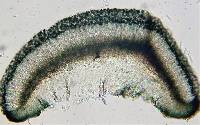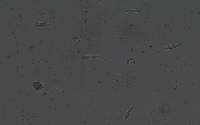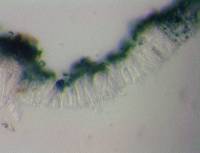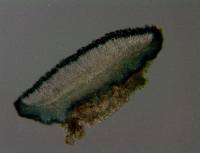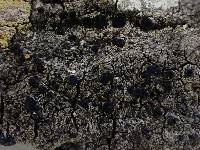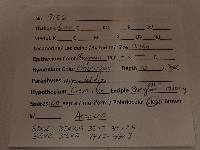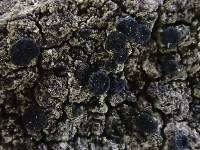
Consortium of Lichen Herbaria
- building a Global Consortium of Bryophytes and Lichens as keystones of cryptobiotic communities -
- Home
- Search
- Images
- Species Checklists
- US States: O-Z >
- US National Parks
- Central America
- South America
- US National Parks
- Southern Subpolar Region
|
|
|
|
Family: Ramalinaceae
|
Nash, T.H., Ryan, B.D., Gries, C., Bungartz, F., (eds.) 2004. Lichen Flora of the Greater Sonoran Desert Region. Vol 2. Thallus: crustose, composed of discrete or contiguous warted to subsquamulose or almost granular areoles, usually continuous (then rimose or not) surface: pale gray, green-gray, brown-gray, or gray-green, sometimes partly or entirely dissolving into finely granular goniocysts that are concolorous with or paler than thallus Apothecia: at first flat, remaining so or eventually becoming slightly convex, 0.3-1.7 mm in diam. disc: black, sometimes with white pruina on edge margin: black, at first distinct, raised above or level with disc, persistent or finally almost excluded exciple: laterally 40-85 µm wide, without or with radiating clusters of crystals, intensely blue-green, often darker along edge than in interior, often ±fading below; edge with 1-3 cell layers thick zone of enlarged cell lumina (up to 5 µm wide) epithecium: distinct, blue-green (K-, N+ purple); crystals not present hymenium: hyaline, 65100 µm tall; paraphyses: 0.8-1.2(-1.5) µm wide in mid-hymenium, apices ±clavate, 1.6-4.9 µm wide, unpigmented or with distinct external hood of granular blue-green pigment hypothecium: dirty brown due to mixture of a brown (K+ purplish, N+ orange) and a green (K-, N+ purple) pigment asci: clavate, 8-spored ascospores: hyaline, 7-15-septate (or a few 3-5-septate), fusiform, tending towards acicular (with one end slightly narrower than the other), 26-62(77) x 3-5.5 µm Pycnidia: ±immersed in thallus, bluish or black, 100-150 µm in diam. conidia: filiform, curved, simple, 7-14 x c. 0.5 µm Spot tests: all negative Secondary metabolites: none detected. Habitat and ecology: on bark of various shrubs and trees (often twigs and branches), sometimes wood, rarely sandstone rock, in more or less open habitats, thin forests, or forest edges near sea level (up to c. 300 m) World distribution: known from coastal Baja California, the Channel Islands of southern California, and a few mainland localities in Monterey and Marin Counties, California Sonoran distribution: relatively widespread on the Channel Islands and two records from westernmost Baja California. Notes: Bacidia coruscans is similar to B. insularis Zahlbr., and Ekman (1996a) treated them as a single species under the name B. insularis. As more material has become available, however, it has become evident that they represent distinct taxa, and B. coruscans is consequently decribed here as a new species. Compared to Ekman (1996a), the description above has been adjusted to accommodate observations from more specimens. Bacidia insularis differs from B. coruscans by its chalky white thallus that does not dissolve into goniocysts, its richly white pruinose apothecia (sparingly so in B. coruscans), a thicker, 3-5 cell layers thick zone of enlarged cell lumina along the edge of the exciple (1-3 cell layers in B. coruscans), the presence of a K+ intensifying brown-orange pigment in the hypothecium (a brown K+ purplish and a green pigment in B. coruscans), its stouter paraphyses averaging c. 1.5 µm in the mid-hymenium (usually not exceeding 1.2 µm in B. coruscans), its distinctly acicular ascospores (almost cigar-shaped in |
|
|
|
Powered by Symbiota



